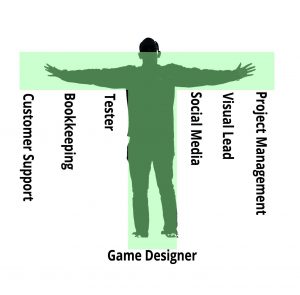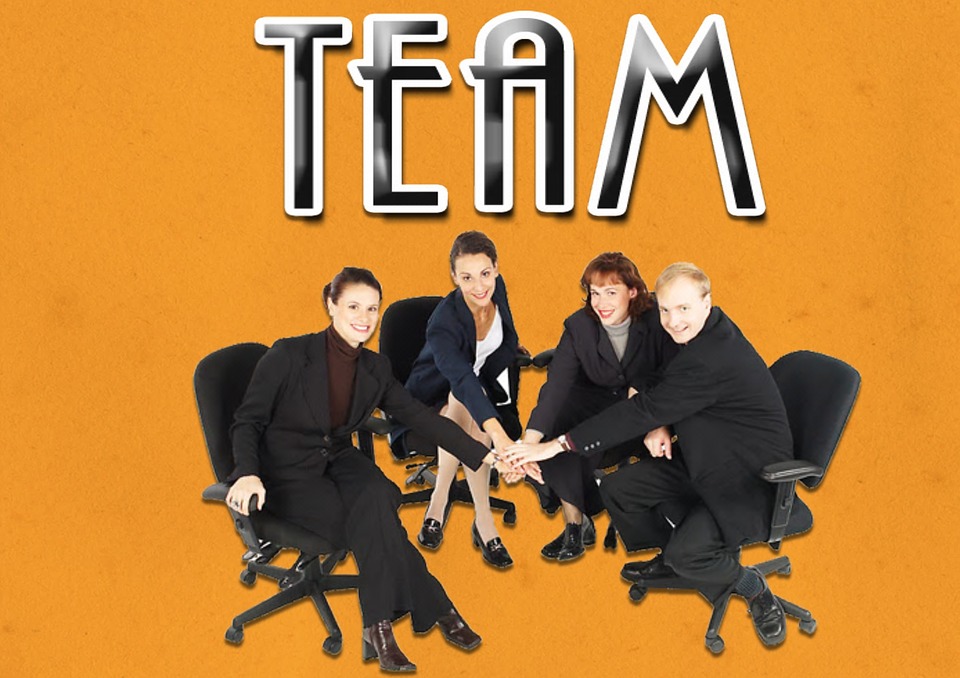There’s something beautiful about being a indie developer. Freedom. Creativity. Flexibility. The feeling of not having a boss micromanage everything you do the moment you step into work. It’s a fantastic feeling.
Just a few quick questions:
- Did you trademark your game?
- Who is answering your support emails?
- When do plan to do outreach?
- And who is going to build your website?
Watch the end credits of any game, and you’ll see dozens of job titles. Someone tracks the finances, someone else manages the production schedule, and someone does all the sound and design. For a solo developer or a small team . . . that someone may be you.
If you’re feeling a sense of anxiety, you’re not alone!
In this post, I’m going to share the many hats that you as a developer need to wear. The fortunate will have partners and resources to outsource many of these tasks. For everyone else: you’re going to have to do some studying.
But I Just Want to Design Games!
I totally understand your feelings.
But let’s imagine that you never bothered to wear the Operations Hat. You’ll miss out on contests, networking events, and interview deadlines. Or maybe you ignored the Communications Hat and said whatever came to you. Your announcements end up causing a backlash and gamers are leaving a score of bad reviews.
Or imagine that no one on your team wants to bother with the Legal Hat and understand basic copyright laws. Your artist “borrows” graphics from other games, and now you’re slammed with a lawsuit that destroys your reputation and delists your game on Steam.
So go ahead: ignore all of this is all at your discretion!
Wearing Multiple Hats
In the Valve Employee Handbook, Valve nailed it with their famous T-shaped people.
[T-shaped people are] . . . both generalists (highly skilled at a broad set of valuable things—the top of the T) and also experts (among the best in their field within a narrow discipline—the vertical leg of the T).
 Running a studio (no matter if you’re a one-person team or many people) is exactly like running your own small business. When you start, you have to do everything. But as you get more experience in multiple hats, it becomes faster and easier. You’ll also know what to look for when you outsource it and can make sure you’re not getting ripped off.
Running a studio (no matter if you’re a one-person team or many people) is exactly like running your own small business. When you start, you have to do everything. But as you get more experience in multiple hats, it becomes faster and easier. You’ll also know what to look for when you outsource it and can make sure you’re not getting ripped off.
Let’s get to the hats!
Visionary Hat
Companies call these wearers the CEO, the Founder, or the head buckaroo. When you wear this hat, you determine the overall direction of the studio. You’re making big picture strategies and deciding on the final decision. But it’s not all fun and games. This hat also includes who you’re hiring/firing and having to make the hard decisions.
How do you wear this hat? Unfortunately, there are no hard rules. Being an exceptional Visionary is gained through practice. No amount of MBA programs or books about leadership will magically grant you mastery. Take the mantle and learn through experience, and more importantly, Start With Why.
Operational Hat
With this hat, you’re focused on the details and figuring out how to execute. While the Visionary Hat wants you to sell one million copies, it’s the Operations Hat that has to plan it all out.
Wearers of this hat are in charge of deadlines, measures milestones and figures out how to best achieve them. To start, get some basic project management skills. Learn how to manage a remote team, how to get started with organizing project tasks, and how to handle large projects. Once you understand the scope through project management – it’s then your job to delegate to your other hats and keeping them on track.
Financial Hat
Wearing the Financial Hat makes you the bad guy. If you’re a small team, being the Financial Hat means getting to tell everyone that they are sharing a room during conferences. If you’re a solo developer, you have to decide if eating ramen for a week or more is worth the professional license of a shiny new tool.
For any business, cash flow is king. Businesses fail not because of bad ideas: they fail because they run out of money. Fortunately, you can hire a bookkeeper for a few hundred dollars a year. Or if you rather learn about managing your studio’s money yourself, two resources I recommend are Accounting Made Simple, which explains accounting in under a few hours, and The Richest Man in Babylon, a classic that teaches you systems that have influenced anyone involved in finances since the 1920s.
Marketing Hat
Game Trailers don’t magically appear. Getting reviews and connecting with Influencers isn’t a passive thing. Someone has to do it. In big companies, the Marketing Hat is broken into multiple departments like public relations, sales, social media, ad buys, content development, etc.. Other tasks include market research, idea validation, monitoring with competitors, finding trends, and finding new ways to grow.
Sounds complicated? Fortunately, there’s help: like this blog, as well as some reliable books about indie game marketing like Alex Eahardt’s Game to Market and Joel Dreskin’s A practical Guide to Indie Game Marketing. (Also, shameless plug to my free guide, the Quickstart Marketing Guide). You can also find services that help you to market.
Tester Hat
At a previous GDC, a speaker off-handedly commented, “Testers are the most valuable but least respected job in the industry.” When you wear this hat, you’ll be documenting bugs, testing fixes, and checking game features. The traits of a good tester are their endurance to repetitive and tedious tasks, troubleshooting and being observant.

The first tester will always be you. Having a good knowledge of game testing will make you more efficient at problem-solving when you have volunteers/hired help. Understand what are good skills to have as a tester and Andrii Vintsevych’s tips on remote testing to better polish your game.
Technology Hat
Technology Hat wearers are about implementing the technology for their team and quickly bringing them up to speed to maximize efficiency. They also need to keep an eye out for new tools that can speed up development time. More importantly, they must have self-control and not recommend every new shiny object that comes their way. Last year’s MUST-HAVE tool might be today’s useless accessory.
A note: these days, it’s more important now to know what you need, rather than how to do it. For example: If you need Net code, it’s easier to outsource it to a top-notch programmer for a few hundred dollars than drowning yourself in programming books figuring it out yourself.
The only way to wear this hat successfully is to stay on top of the latest tech trends of your favorite tools.
Communications Hat
In a traditional business, this is your Community Manager, a customer support specialist, and your social media person. Wearers of this hat are answering customer-facing queries. Excellent communication with fans leads to a more happy fanbase. Bad communication can get viral and send a lot of hate your way, no matter the quality of your game.
Two great resources to start with are Art of Explanation, for guidance on framing and better articulating your message. For more resources on exceptional customer service, check out The Best Service is No Service by Amazon’s former Global VP of Customer Service, as well as Helpscout’s blog.
Visual Manager Hat
Other roles include graphic artist, website designer, and animator. With this hat, you’re in control of the overall visual design of everything customer-facing. That includes your website, your game logo, your email newsletter and your business card.
If you want to get started, some skills you want to look into are style, color, and shapes, and how players see them. Your logo design, UX design, and how to make a good trailer.
Legal Hat
I’ll never forget the words from the judge: “Ignorance of the law is NO excuse.” (I was in court for a parking ticket, btw.)
Wearers of this hat know what’s required if you form a company, what type of contracts to write for freelancers and partners, and how to trademark your work. If the idea of a good time for you means swimming through thousands of pages of legal jargon, then this is for you. Everyone else (which is like 99.99% of us): find professional help.
Indie development is international, and laws vary. The best suggestion from my experience is to be informed, and bring those questions up with your professional. I do want to shoutout to /r/VideoGameAttorney, which has been sharing legal advice for indie developers on Reddit and to check out his blog.
The Morale Booster Hat
For years, I believed morale was all BS—men in suits singing kumbaya and creating cheesy team-building videos. I thought bad company culture was the norm, everyone was a complainer and major companies like Google, Amazon, and Zappos who create job titles like “Chief Culture Officer” were just throwing money away.

“Go teeaaammm wooo!” (Image via Pixabay)
Then I experienced what amazing company culture looks like. Wow, what a difference. I’m a believer—and I’m now convinced of its must-have effects. Good company culture boosts morale and gives employees ownership and a sense of self-worth and value. Productivity increases because everyone feels heard and workplace drama is non-existent (absolutely glorious!).
For small studios (and solo developers), think of it this way: when developers stop caring, quality suffers. Self-motivation can quickly die out and panic can spread like wildfire. Keep the mental health of you and your team in check with Cliff Harris’s post and Carolyn Van Eseltine’s post.
It’s Beginning to Look a Lot Like TF2
Looking above . . . that’s a lot of hats! But if it were easy, everyone would be doing it.
Game development isn’t for the weak. But that’s why you’re here: because you have an important message and you’re willing to take on multiple responsibilities. Through this process, you probably see hats that are perfect for you, and hats that someone else should wear. Your experience wearing all of those hats will make you super valuable to anybody in any industry.

